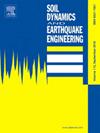Study on the resonance response of soil–pile-nuclear island structural system under seismic excitation
IF 4.2
2区 工程技术
Q1 ENGINEERING, GEOLOGICAL
引用次数: 0
Abstract
Resonance can significantly amplify a structure’s response to seismic loads, leading to extended damage, especially in critical infrastructure like nuclear power plants. Thus, this study focuses on the resonance effects of the dynamic interaction between layered soil, pile foundations, and nuclear island structures, which is particularly important given the limited availability of bedrock sites for such facilities. Specifically, this study explores the resonance behavior of nuclear islands under various seismic conditions through large-scale shaking table tests by developing a dynamic interaction model for layered soil–pile-nuclear island systems. The proposed model comprises a 3 × 3 pile group supporting the upper structure of a nuclear island embedded within a three-layer soil profile. Sinusoidal waves of varying frequencies identify the factors influencing the system’s resonance response. Besides, the resonance effects are validated by inputting seismic motions based on compressed acceleration time histories. Furthermore, the impact of non-primary frequency components on structural resonance is assessed by comparing sinusoidal wave components. The findings reveal that resonance effects increase as the amplitude of the input seismic motion increases to a certain threshold, after which the effect stabilizes. This trend is particularly pronounced in the bending moment response at the pile head. Additionally, an independent resonance phenomenon is observed in the superstructure, suggesting that its resonance effects should be considered separately in nuclear island design. Similar resonance effects are observed when the predominant frequency of sinusoidal waves closely matches the compressed seismic motions, suggesting that sinusoidal inputs effectively simulate structural resonance during seismic design testing.

求助全文
约1分钟内获得全文
求助全文
来源期刊

Soil Dynamics and Earthquake Engineering
工程技术-地球科学综合
CiteScore
7.50
自引率
15.00%
发文量
446
审稿时长
8 months
期刊介绍:
The journal aims to encourage and enhance the role of mechanics and other disciplines as they relate to earthquake engineering by providing opportunities for the publication of the work of applied mathematicians, engineers and other applied scientists involved in solving problems closely related to the field of earthquake engineering and geotechnical earthquake engineering.
Emphasis is placed on new concepts and techniques, but case histories will also be published if they enhance the presentation and understanding of new technical concepts.
 求助内容:
求助内容: 应助结果提醒方式:
应助结果提醒方式:


